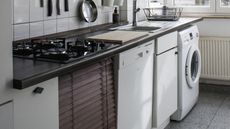Appliances
The latest Appliances breaking news, comment, reviews and features from the experts at T3
Explore Appliances
-

Salter just dropped a new kitchen appliance range – and it has every gadget you could possibly imagine
Introducing the Alchemy collection...
By Lizzie Wilmot Published
-

This Tower air fryer uses AI to calculate cooking temperature – and it’s super affordable
Tower’s new AIRX air fryer has built-in AI that’s genuinely useful
By Bethan Morgan Published
-

Cuisinart Blast & Go Portable Blender review: easy, convenient and surprisingly premium
Here's my take on Cuisinart's latest kitchen gadget
By Lizzie Wilmot Published
-

3 best air fryer launches from 2025 you should know about – if you don't already
My favourite air fryers from the year, and why they deserve a place in your kitchen
By Bethan Morgan Published
-

Best kettle 2025: the highest-ranking multi-temp and standard models
The ultimate vessel for a perfect cuppa
By Lizzie Wilmot Last updated
-

Best robot vacuum cleaner 2025: hands-free cleaning while you're out
Find the best robot vacuum cleaners from top brands including Roborock, iRobot, EZVIZ, Eufy and SwitchBot
By Lizzie Wilmot Last updated
-

Best bean-to-cup coffee machine 2025: top picks for coffee lovers
Find the best bean-to-cup coffee machines that incorporate a grinder, espresso maker and milk frother in one handy box
By Bethan Morgan Last updated
-

Best fan 2025: cooling gadgets for summertime and all-year-round relief
Find the best fans – desktop, tower, evaporative, you name it – from Dyson, Meaco and many more
By Bethan Morgan Last updated
-

Dyson’s new vacuum line-up is finally available to buy – I’ve tried them and this is the one you should pick
Dyson releases cordless, robot and hard floor vacuums before the year is up
By Bethan Morgan Published
-

Cuisinart takes on Breville with new smart toaster that saves your toast settings
Cuisinart debuts two new toasters including smart and classic models
By Bethan Morgan Published
-

Best electric barbecue 2025: indoor and outdoor grills for all-year-round cooking
Find the best all-in-one electric barbecues and grills with plug-and-play convenience
By Bethan Morgan Last updated
-

Roborock unveils its first-ever robot vacuum cleaner with a roller mop
It's also the priciest model in the Curv series so far
By Lizzie Wilmot Published
-

Shark FreeStyle Pro Cordless Upright Vacuum review: simplicity is the key to this vacuum’s success
Shark’s FreeStyle Pro is a commendable cordless vac that ticks many boxes – but not all
By Bethan Morgan Published
-

Pantone’s 2026 Colour of the Year is underwhelming, but these appliances can incorporate it in your kitchen
Is anyone else deeply disappointed by the 2026 Pantone Colour of the Year?!
By Bethan Morgan Published
-

Calling all tea lovers – this ingenious teapot brews the perfect cuppa without electricity
Ex-Dyson designer reinvents the teapot
By Bethan Morgan Published
-

How much does it cost to run an electric heater? I’ve done the maths so you don’t have to
Is it really more cost-effective to use an electric heater than turning on your heating?
By Bethan Morgan Published
-

Blueair Mini Restful Sunrise Alarm Clock and Air Purifier review: bright lights and powerful airflow in a stylish design
Blueair combines an air purifier with a wake up light – and I’m surprised other brands haven’t done this sooner
By Bethan Morgan Published
-

Cuisinart Grind, Tamp and Brew Espresso machine review: A premium experience for coffee buffs
Cuisinart’s high-end espresso model offers full control from bean to cup for hot or iced barista-style drinks
By Rob Clymo Published
-

7 robot vacuum deals to upgrade your cleaning routine this Cyber Monday
Save big on robot vacuum cleaners and mops in these cheap Cyber Monday deals
By Bethan Morgan Published
-

7 best Cyber Monday Dyson deals LIVE – the biggest price cuts on vacuums, hair stylers, fans and more
Want to save some cash on Dyson products? T3 has found all the best offers here…
By Bethan Morgan Last updated
-

I test air fryers for a living – here are 11 Cyber Monday dual air fryer deals you should buy
The best Cyber Monday savings on dual basket air fryers from Ninja, Tower, Philips and more
By Bethan Morgan Last updated
-

13 small air fryer Cyber Monday deals – perfect for tiny kitchens
Get up to 50% off single air fryers for smaller kitchens and spaces
By Bethan Morgan Last updated
-

7 cheap Cyber Monday dehumidifier deals to prevent your home getting mouldy this winter
Save big on these dehumidifiers from Pro Breeze, Duux, Bosch and more
By Bethan Morgan Last updated
-

I built my dream kitchen with these 7 appliances – and they’re all on sale for Cyber Monday
If I didn’t already have these kitchen gadgets, I’d be buying them in the Cyber Monday sales
By Bethan Morgan Last updated
-

7 Cyber Monday kettle deals that will upgrade your cuppa from Smeg, KitchenAid, De’Longhi and more
Calling all tea drinkers – get huge savings on kettles this Black Friday
By Bethan Morgan Published
-

3 kitchen appliances you shouldn't leave plugged in at night, according to an expert
A little caution now can save a big headache later
By Lizzie Wilmot Published
-

My favourite condensation-busting cleaning gadget is half price on Amazon right now
If you have to buy one thing this Black Friday, let it be this
By Lizzie Wilmot Published
-

Everyone’s favourite ice cream maker – the viral Ninja Creami is 40% off in cheap Black Friday deal!
It’s never too cold for ice cream…
By Bethan Morgan Published
-

Best coffee pod Black Friday deals 2025: save big on your daily brew
Including discounted favourites from Nespresso, Lavazza, L'OR, Nescafé and Keurig
By Lizzie Wilmot Published
